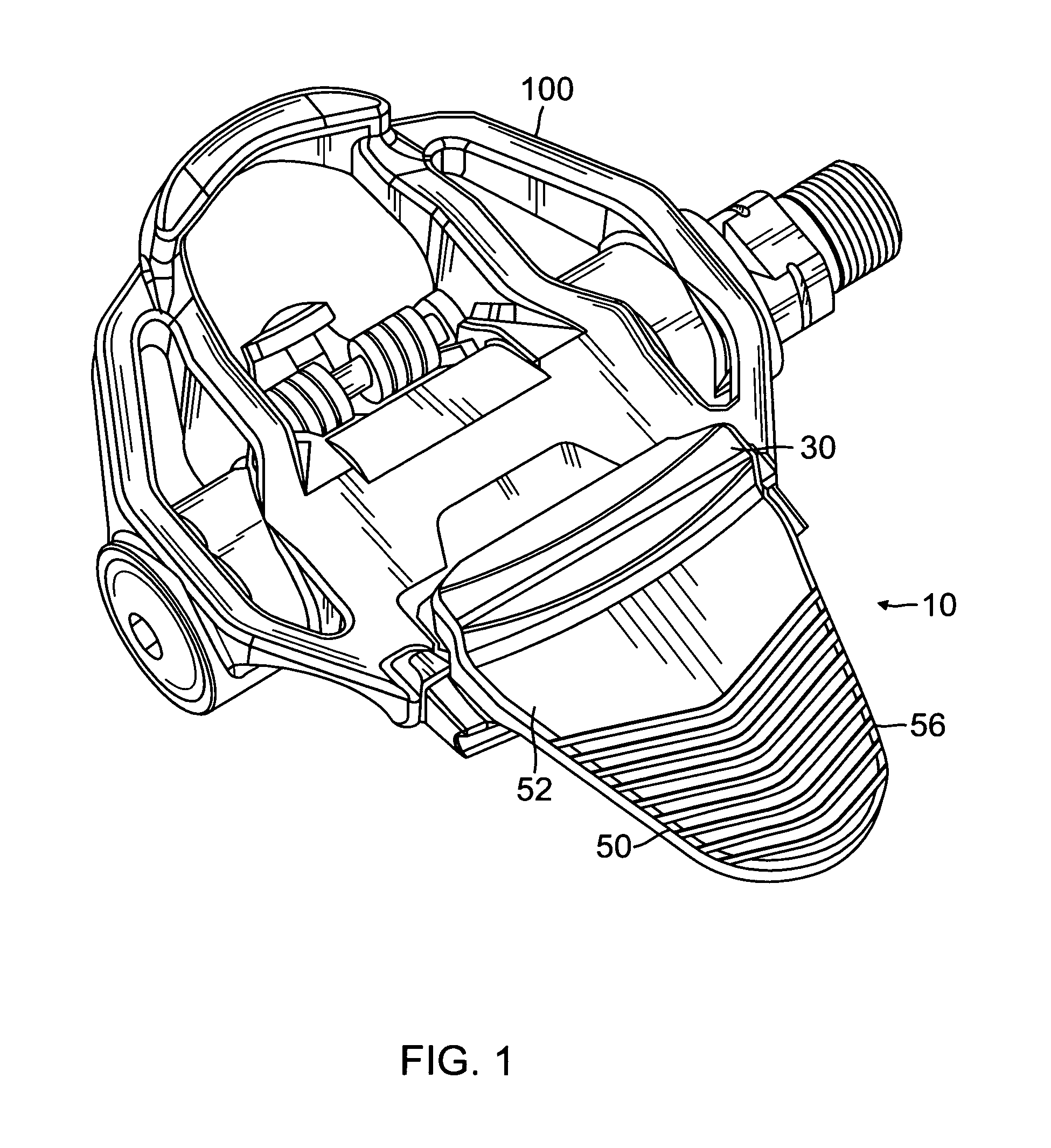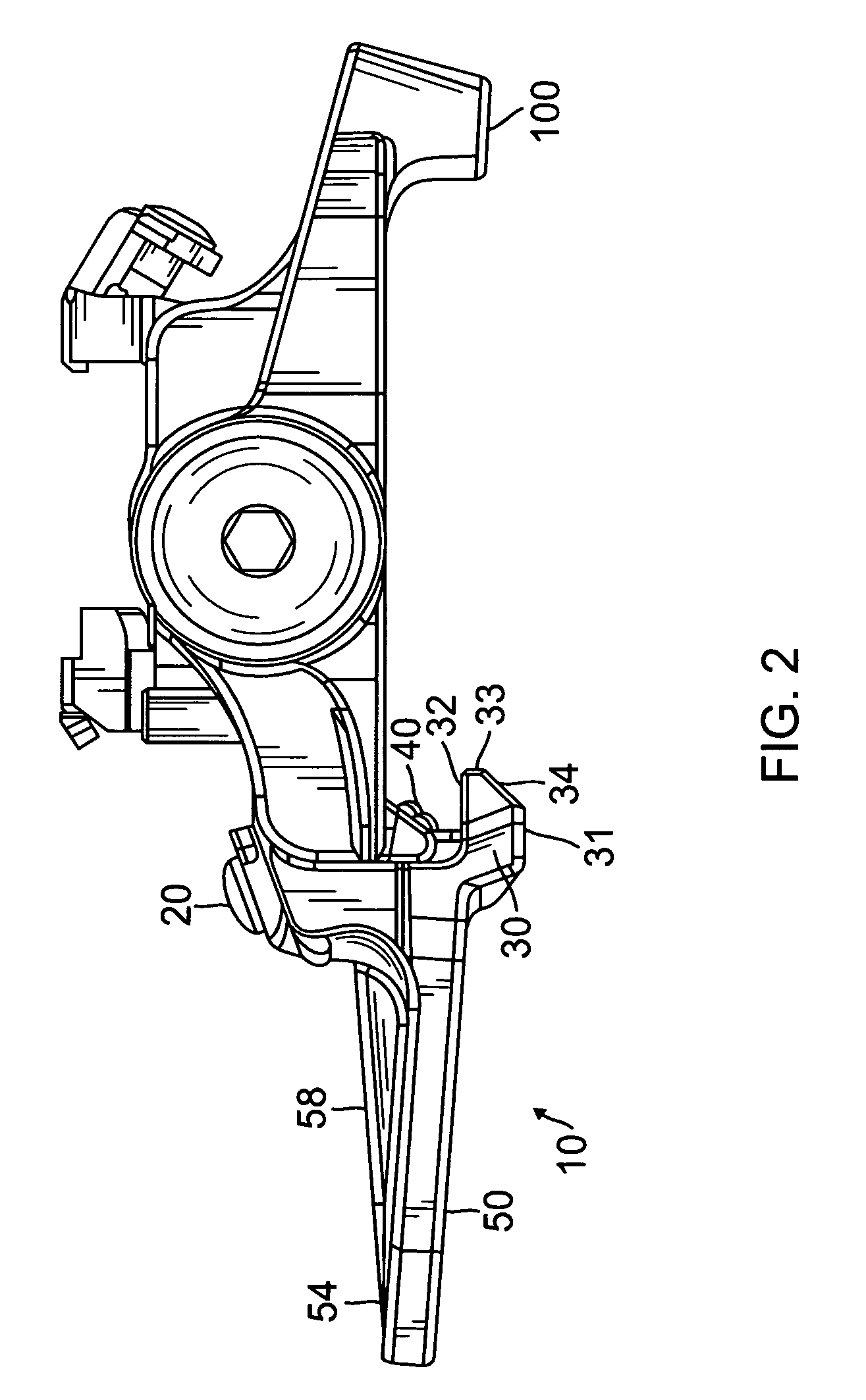[0015]Insertion of the cleat adapter into a clipless pedal having the present invention retention and release mechanism is the same as with the prior art, in that the shoe cleat or toe clip is inserted into the front receptor and snapped into the rear receptor, with the present invention in place of the standard rear receptor. Removal of the shoe cleat or toe clip does not follow the prior art. There is no need for any sharp twisting movement of the ankle, instead, merely pressing on the spar lifts the rear receptor at the opposite end of the spar upward, thereby releasing the shoe adapter or toe clip. There need not be a lot of upward movement, only enough movement to sufficiently release the adapter. Pressing on the spar is usually done by hand and by the cyclist. In other words, the cyclist, having a shoe still attached to the pedal, can just reach down and press on the spar to release a shoe adapter. Additionally, anyone can press on the spar to help the cyclist. For the removal of toe clips, the same process is available, or the cyclist's foot can be removed first and then push on the spar to release the toe clip. The mechanical advantage provided by the spar means that very little upper body strength is required from the person attempting to release the shoe adapter or toe clip, particularly as compared to the prior art. Children and the elderly will experience no difficulty in releasing a shoe adapter or toe clip like they have in the prior art. Everyone using this device, those both with and without upper body strength, will be able to remove shoe adapters and toe clips with ease and grace. The preferred embodiment of the spar has grips along the spar to aid the user. If a cyclist has been sweating, or has hands that are moist from sweat from gloves and the like, the cyclist's hands won't slide off the spar, and instead, the cyclist will have a non-slip, frictional location on which to press down on the spar. This, too, is absent in the prior art, and is yet another advantage of the present invention.
[0016]The retention and release mechanism of the present invention is preferably a spring-loaded device. The default position of the present invention is in the retention mode. It is when force is exerted on the spar that the present invention enters the release mode.
[0017]The lateral spar is of a length sufficient to provide the least amount of effort on the part of the user and yet not interfere with the cyclist or with the pedal movement. The spar should not hit the ground at the end of the down-cycle or at the beginning of the up-cycle of the peddling process. The spar preferably has a grip to further aid and ease the release of the shoe adapter. The spar may have braces, preferably underneath the spar, to support and buttress the spar. The spar may be made of any material that is appropriate for rear adapter receptors.
[0018]The present invention operates by first being inserted in a clipless pedal, a double-sided clipless pedal and the like, as the rear retainer in the clipless pedal. A toe clip or shoe adapter, having already been inserted into the clipless pedal, is removed quickly and easily in the following manner. Downward pressure is exerted, usually by hand, on the back end of the pedal on the spar of the present invention rear retainer. The presence and length of the spar allows the user to easily overcome the resisting force of the tension spring actuator, using just a little downward pressure, thereby stretching the tension spring or springs, resulting in the cleat retainer lifting its clamp head off the back of the toe clip or shoe adapter. Prior to the exertion of a downward pressure on the spar, the tension spring(s) actuator had provided a force on the clamp head so that the clamp head could keep pressure on the rear retainer of a toe clip or shoe adapter to hold it securely in place. Downward pressure on the spar results in overcoming the resisting force of the spring(s) actuator and raising of the clamp head. Raising of the clamp head means that the toe clip or shoe adapter is available to be removed from the pedal. All of these actions occur simultaneously with the exertion of downward pressure on the spar, which means that as soon as someone pushes down on the spar, the toe clip or shoe adapter is removed. Additionally, the presence, length and location of the spar provide a further advantage to the clipless pedal overall, because it means that the present invention rear retainer and release mechanism requires far less force to release a toe clip or shoe adapter than that required by the prior art, because the present invention rear retainer and release mechanism not only provides an actual place for the hand to grab a hold of and press down on, but also has grips, both of which are unique in the industry, and because the present invention rear retainer and release mechanism creates a faster, easier, and elegant solution to the afore mentioned problems in the prior art.
[0019]It is an object of the present invention to provide a spring-loaded bicycle cleat retaining and releasing mechanism to provide a mechanical advantage in order to reduce the amount of force needed to cause the cleat retaining mechanism to move away from the retained bicycle cleat.
[0020]It is an additional object of the present invention to provide a cleat retaining and releasing mechanism that provides a cleat removal that does not require a sharp motion that is lateral and in or parallel to the plane of the pedal face.
 Login to View More
Login to View More  Login to View More
Login to View More 


